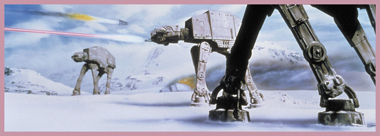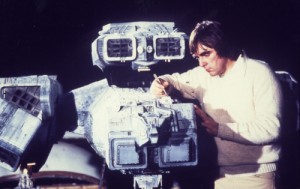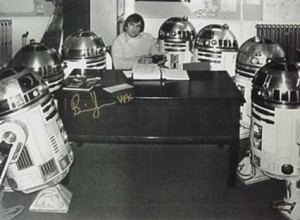Brandon Alinger of the Prop Store of London has shared some interviews with me with permission to publish them on the Original Prop Blog for readers to enjoy. The first interview is with Academy Award winning Special Effects Artist Brian Johnson.Brian Johnson’s work in special effects includes classics such as 2001: A Space Odyssey, Space: 1999, Star Wars: The Empire Strikes Back, Dragonslayer, Alien, Aliens, and more.
Brandon Alinger, Stephen Lane, and Andy Goulding spoke with Mr. Johnson in May 2005, and below are transcripts from the audio tapes. All of the following text content is copyright Brandon Alinger.
***BEGIN TAPE***
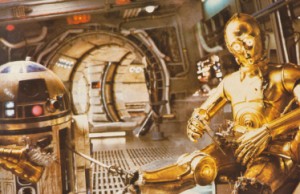
Brian: That’s one of the other droids. These were made by a guy called Francis Coats, who was a really superbly, completely crazy, but absolutely superb molding man. And he worked with a guy called Tony Dyson. Tony Dyson was a bit naughty and made a copy for himself, and a mold and started trying to sell them. And the might of ILM and George Lucas came down on him.
Brandon: So did you reuse any of the original Star Wars R2s for Empire?
Brian: No, we didn’t. We got them running really well. Kit West, who took over and did the third one, took our ones and did the sensible thing, put the chain drains on them, and then I think they were virtually faultless. [Looking at photos] Mechanisms everywhere.
Stephen: That’s a great one.
Brian: It’s terrific isn’t it? One of the questions I ask myself is if you go 1-2-3-4-5-6, 1- lots of CGI, 2- even more CGI, 3- oh my god, even more CGI, 4- hang on a man, where’s all the… 5, 6, it’s an odd way around. I guess, I guess, George will be enhancing the other ones in a further release at one time or another.
Stephen: I would love to see the originals back out on DVD without the changes. The feel of them is so different.
Brian: Yeah. [Looking at photos] That’s my ex-secretary Gilly Case… gun mechanisms… Yoda! That’s fantastic isn’t it? Thank god he’s still alive. What would they do without Frank Oz?
Brandon: That was the remote control one for the backpack.
Brian: Yeah, yeah. I know yeah…. John Hatt.
Stephen: That’s another great droid that one actually.
Brian: John Pakenham. Who’s now exploring the Arctic, the Antarctic I think.
Stephen: Really?
Brian: Yeah, we had quite a few droids to do on that. They were interesting.
Stephen: We’re all hoping one of those would turn up aren’t we. [Stephen tells story of us chasing pieces in Norway and ending up with nothing]
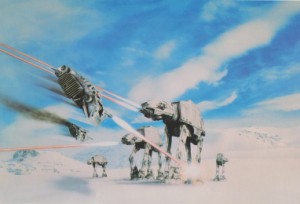
Brian: [Talking about AT-AT] That was a work of art, that thing. Tom St Amand built that, Canadian guy, and the armature was visible. That’s a unique animated object for that time. Because all the mechanisms actually functioned to enable you, to enable Jon Berg, to animate it. And Tom made all those mechanisms. They were like to one ten-thousandths of an inch type stuff. They were sort of that size, and then 4 foot was the highest one – we blew it up, actually.
Stephen: Was there just one four foot one?
Brian: There were 2, I think there was a semi-dummy one used for the bangs… and the set, you’ve obviously seen it, and it had to have the trap doors in it. They had to climb out with their counters, and they get these counters… I used to watch this for 10 minutes, 15 minutes, and then I’d go back to my office. That would be sort of at the beginning of the morning. And then by 11 o clock at night, they might finish one shot. They’d come into my office, and they’d be drained. Completely drained. They’d be crawling about under the set, have to very gently lift the trap door up, climb up, get the caliper, put it in the position, mark it, get it set, make the move, very carefully get everything back, climb down inside, close the lid, push the button, and up they’d come.
Stephen: What a daunting task.
Brian: They are absolute stars in my book. Jon went on to do a lot of things after that, although I notice Phil does more animation in 3D graphics now, but I’m sure he still does it sometime or other, but it’s a whole mental attitude thing- to be able to see how all those moves are done.
Stephen: Yeah that’s right, it’s thinking it through from start to finish – and then doing it.
Brian: Yeah. And when he would have fun with things, like when we had the big worm inside the cave, which he did with his hand inside the puppet. To him that was brilliant – he could just do it in real time. We shot it in high speed, so that it looked even bigger. He used to come out with a big grin on his face, because we’d roll the camera and 10 seconds later we had the shot, as opposed to it taking all day.
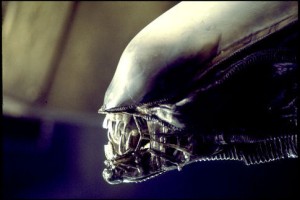
Brandon: There’s a few in here from Alien also…
Brian: Oh god. Yes… What happened with Alien, is that Carlo Rambaldi turned up, and the spring mechanism for the jaws and everything was too wide, we had this guy called Belardi who had to get inside the costume. He was a messiah tribesman, he was like seven feet one inch, something like that, seven feet two, and the widest bone in his body were his knees. Wider than anything else. Ridley didn’t like the shape of it, so it had to be altered.
Although Carlo Rambaldi built it, we actually had to also get involved in making it work. Oh here we go…who took these? Martin Gant again? Oh right. This was at Bray. Bray Studios. What I did here was, because Ridley is- Ridley is an ace sketch artist, that’s what he used to do before he became an art director, and before he got involved in other things – commercials. So he used to go away and on a bit of paper scribble, you know, I want it to look like this. And then Ron Cobb used to turn it into a 2-dimensional work of art. And then Ridley would say yeah that’s pretty good, I like that.
So in the end what happened was, I said, okay, and I showed him a perspective drawing/sketch of the top of the tower, which is one of those trick of eye things, so that it looks like the water is always going down the waterfall, but you know, if you follow it around at one point it has to… you know?
So I said okay, do you want me to build this? Got the message, so I said, I’ll build you a small scale model of the Nostromo, and then you can do whatever you want to it. You can always cut it in half, extend it, you know. But if we start with sort of a 16-foot model, we’re never going to finish it. So that’s what I did.
I had this small scale model made, god knows where that went – maybe Ridley’s got it, I don’t know. And he said, yeah that’s great, but can we do it… and then he started the spikes on it, things like that and everything else. And then we got to the point where we started to build it, we did begin to build it, and then he added a few more bits and pieces.
We got the basic shape sorted out by having a small scale one that we could talk about. Because my space skies, which were PVC shop-interior decorating shop PVC, shiny PVC, stretched over a 2×1 frame. And then we’d get a toothbrush and some white paint, and just flick it on like that. And the stars appear. Then we’d get an airbrush and just airbrush a bit of galaxy in. I used to do them in like 15 minute at the most.
Stephen: Wow. 15 minutes to build a galaxy.
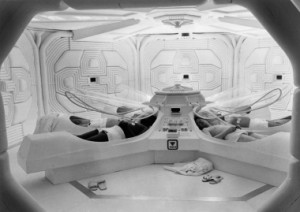
Brian: Well, when I was on 2001 with Doug Trumbull, we had shiny black card which we used, we lit it from the sides, and then we had the camera covered in black velvet, so that we didn’t get any reflections. Because Stanley had got Tony Masters, who was the art director, and a load of other people, to get electric drills and drill holes through sheets of aluminum, and then they tried to backlight it. But when you try to force large amounts of light through tiny pinholes, it doesn’t work too well.
And then when I was working on Space:1999, I thought back to the 2001 thing, and then found this wonderful stuff, this wonderful plastic – PVC. And it was made rolled face to face, so when you peeled it apart very carefully, you had two huge sheets, that were maybe 6 feet by, a mile long if you wanted it a mile long. So that’s what we used, for the star backings.
What happened was, we shot at Shepperton, I was working at Shepperton on Alien, and then because I had a contract with Lucasfilm to do Empire Strikes Back, I had to leave Alien after they’d finished the main unit shooting, and while they were halfway through the model photography. And Ridley thought I was just leaving. I wasn’t leaving, I didn’t have any choice in the matter. It was Fox who said I could do both pictures. So that’s the reason…
It’s a great movie, though, isn’t it? When I read Empire Strikes Back, it didn’t hit me as being a fantastic story, because it was so complicated and it had to pick up from the last one and it had to lead on to the next one. It wasn’t quite the same as this, where you start off, there’s a middle, and an end, the whole thing is there, isn’t it? When I read the script, Dan O’Bannon’s script, I finished it and thought “Jesus, I’ve got to work on this. This is too good to miss.” It was fantastic.
When I started on it, it was Walter Hill who was going to direct it, not Ridley Scott. And then he moved on to do other things, and they got Ridley Scott. We started off, and we had – John Finch was the character that John Hurt took over. And John Finch went into the sculptors place to have his life mask done, and he hadn’t told anybody he was a diabetic, and he had to discover while he was inside his life mask. And he actually passed out. And they went, okay John, and there was no response. And they got the ambulance out there and dragged him out. Because he hadn’t declared that on his insurance, the company couldn’t go on using him.
So we had a 2 week period – we’d been filming on the interior of the Nostromo, in the cabin. The set was probably 4 or 5 feet higher than how you see it on the film. Because Ridley was shooting, in 2.35 or whatever it was, I can’t remember the format now. It was letterbox, anamorphic. He couldn’t get the roof of the set, and the actors and everything else in. He was getting really frustrated. John Finch was out and they had to wait two weeks for John Hurt to come on board, and in that time they got a saw and cut four or five feet out of the set, to make it neat.
And then he had his thing with everything hanging in the top of it. So that was very fortuitous. Peter Voysey was the sculptor, he’s no longer with us, he stepped off a curb in France and got hit by a car, he looked the wrong way. The car was coming from the other way. He was an absolutely fantastic sculptor. That’s a bloke called Martin Bower. He worked for me originally on Space 1999. And then his models were notorious, because I don’t know what glue he was using when he first started, but his models kept falling apart. So we had to give him a lecture on how to actually glue things together. That’s one of the Italian guys. You can see all those springs running around there.
And Carlo Rambaldi, he used to come onto the set, and he had a manager who was completely dressed in black, head to toe. Very sharp Italian suit, and Carlo would come on and Ridley would say something and the manager would translate back and forth. When you’re outside a meeting, and you caught Carlo speaking, he’d be saying “we have to do this and that”…he was pretending he didn’t know English, so he could listen to what everybody else was saying. A lot of that going on as well. Politics. And of course lots of things got changed with Ridley, because the thing with Ridley is, he doesn’t like to keep going and pushing frontiers and things, and the mechanisms were all altered and such. It’s gotta be just right for someone like that.
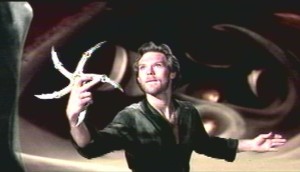
Stephen: Was there just the one main hero mechanism, or..?
Brian: No, I think we had two.
Oh, God yes, Krull. I had nothing to do with that. That was the film – who was the director of that. He did Bullitt. The name will come back – Peter Yates. Peter Yates did Krull, and it all started to go really pear-shaped. He hated it, he really hated it. But he had to do it, as part of his contractual agreement. This is the story I was told. I was told. They were halfway the production, cause Derek Meddings did the effects on it. And I was asking Derek about this, and he said oh this is happening and that’s happening. And he says you’re not gonna believe this, but Peter Yates has decided he is going to take a holiday. So we’ve got to stop for three weeks while he goes to the Caribbean for a holiday. In the middle of shooting.
There’s the infamous spider. That’s actually the best animation bit in Krull. That’s a fair sized model, isn’t it.
This is from Alien… Ash. What I think, the reason why Alien worked… A: the script was pretty good. B: Ridley didn’t overexpose the Alien. It wasn’t in your face the whole time.
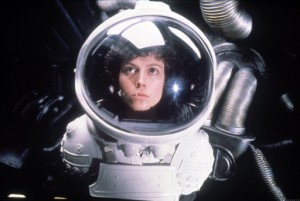
Stephen: Yeah, you were always craving to see more.
Brandon: Leave it to the imagination.
Brian: Yeah. And this is a film where right in the beginning I had to decide whether we going to shoot motion control, or to shoot it as a model using a camera that tracked along the ground very slowly, and not have to do any multiple exposures or anything like that. Because when you read the script, what’s really important is what’s on the inside, and you just need to cut outside occasionally, you don’t have to do some huge techno-lust move through the spaceport. It doesn’t tell you anymore than a shot of the thing just cruising through space. So we didn’t have to spend money at that time, though I was actually developing a motion control system, but it wasn’t far enough advanced to actually do a feature film. So we didn’t do it that way, we just did it with straight models, and basically one frame a second or two frames a second, both actually. And the camera just crept along with a little motor driving it along, so we got motion from that. And that worked alright.
Stephen: It must have been an incredibly exciting time, to wind up on this and go straight into Star Wars.
Brian: Absolutely.
Stephen: And you mentioned earlier that was due to contractual obligations?
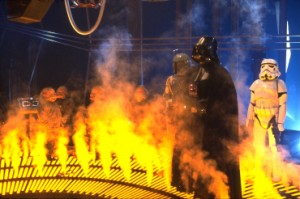
Brian: Yeah. What happened was – I was working on Space 1999. And two blokes came to the studio, and said can they have a look around to see what I was doing. We had already done the first series of Space, and we were about to start the second series. We were just coming to the end of the first season, that’s right. So they came in and they had a look around, and they asked me all sorts of questions – how would I do this, how would I do that. I said I’d do this motion control, etc. And then they went away and one of them came back and said we’d like you to do this picture called Star Wars. I said I can’t, I’ve just signed literally yesterday with Gerry Andersen to do a second series of Space 1999. They said look, whatever happens, we’d like you to do the second one, we’re gonna make nine. I think it was nine at the time. That was Gary Kurtz.
The other guy was George Lucas. And they’d walked around my studio, I didn’t know who they were. They mentioned American Graffti, and I’d not seen that. They both asked really pertinent questions, so I wasn’t dealing with guys who didn’t know what they were talking about. They definitely weren’t normal producer type people, they were definitely hands on technician types. And I thought oh well that’s it, lost that job. And then Star Wars came out, and I was talking to the guys on Star Wars, the technicians. They said oh it’s a pile of crap, they don’t know what they’re doing. They’re like a bunch of amateurs, they’re this, they’re that. And the same people, after they’d been to the crew screening, I saw two of them again. I said how’d it go. “Fucking amazing! The best thing ever.” So I thought oh well that’s it.
And then the phone rang, and it was Gary, and he said we’d like you to do Empire Strikes Back. So I said when does that start, and I said, “yeah, I’d love to do it”. And then I had a call from Peter Beall, who was head of Fox in the UK, and he said I’ve got this project here it’s called Alien. Can you come and talk to us about it? I said well I’ve just signed for a thing with George Lucas and Gary Kurtz. He said, “oh it’s another Fox production, I’ll sort that out”. And he came back and he said yeah you can do both, they won’t overlap, there will be a gap, just a short enough gap, and you can just about squeeze it in. “Okay, thanks.” So that’s what I did.
I signed for both. Of course what happened was, Alien turned out to be a right bloody drama, and it took much longer, and we overlapped. I got a phone call from George’s secretary saying you’ve got to be in San Rafael, because I’d been going out there on occasion. When I went out there it was just a shell, there was nothing in it, and then we got it going. So she said you’ve got to come for this meeting. And that was that. I had to say sorry to… but then Nicky Allder was fine, and everything else. So the boys were okay. Ridley could just go down there and tell them what he wanted… but he thought I was leaving, but I didn’t have any choice in the matter. I was contracted to George before I agreed to do Alien.
And then some years later, I got a call from somebody called Gale Anne Hurd. She said we would like you to do the effects on Aliens, and my husband is going to direct it, a chap called Jim Cameron. He’s just done Terminator, which we made for two million dollars, four million dollars, something ridiculously small. She came over with him, we had a chat. And he said “I have to use this company called LA Effects. Cause they have this special motion control gear.” And I said well you’ll have to check with the powers that be about bringing the stuff over from the states. Because at that time there was a big union thing about having too many people coming over with stuff that, if we could supply it from here we’d supply it from here. They said no, you don’t have anything like this stuff.
So they came over, I got a phone call from Gale saying I’m really sorry, but because LA effects are doing – they’re contracted to do the whole thing. So we’ll have to ask you to not participate in the show. I was really pissed off at that. About six months I got a phone call, it was Gale saying can you come and see us, we’ve got a problem I wonder if you can help us out. LA Effects had basically come over with two stepper-driven Navy-range cameras covered in salt, and started… And Jim had blown his top when he’d seen this, because he thought it was going to be serious motion control gear.
And I had a company called Arkagon at Bourne End Studio, and they fired LA Effects, and I took over, and I did all the post production stuff and some of the model shooting. And some of the live action still going on. At the end of it, my name was put up for a nomination for the Academy Awards. And Susanne Benson, who was the hairdresser many years ago, was married to the LA Effects owner, took my Academy Award. She hadn’t done a single thing, anything to do with visual effects. Other than she was going to Paris and buying clothes, and things like that. And that was when the Academy changed the rules. They said the only person who can receive an Academy Award for Visual Effects has to be somebody who is actually a visual effects person, and there can only be X number of people.
Because Jim had gone to the Academy and pleaded for me very kindly at the Academy screening for the nominations, for half an hour, very eloquently, but the rules were the rules and they could only have four people. But because I was the last person on the show, and Fox had signed a contract with these LA effects that said in the event of the movie getting a nomination, one of the LA effects people had to be involved. Otherwise there was a penalty of like 70,000 dollars or something like that. So they said, “yeah, we’ll give it to Susanne here”. It’s still sour grapes as far as I’m concerned.
But Jim had a special award for me, at Tiffany’s, in crystal, and gave it to me. It’s really nice – it’s absolutely unique. So that it was okay. But it still bugs me occasionally when I think about it, because to come in and take over and get things going and stuff was quite a schlep actually.
The great thing was working with Jim Cameron. You had to listen to what he said, and if you gave him what he asked for he was fine, it was when you listened to him and didn’t give him what he wanted that the shit hit the fan. That was a good movie too, wasn’t it? The great thing was, it was completely different from the first one. It was a real shoot-em-up job, wasn’t it. And just when you think it’s over…
***END TAPE***
***BEGIN TAPE***
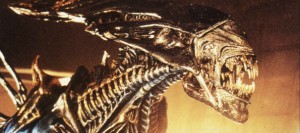
Brian: Well, you know, it was a hell of a movie to work on, and Cameron knew exactly what he wanted, and he was very clear about he wanted things to be. He usually never changed his mind – once he made up his mind about something, he was another art director, special effects guy, and he’d done all that. So we got to one point where the dropship is going through the clouds, we decided we’d better do the clouds using hot wool stuff, you know, Kaypox stuff, so I thought yeah I’ll do that. So I go there and start putting these things up. Jim comes in and looks at it, and he goes and he does a really superb job I have to say, it was 10 times better than the one I did – and that’s the one we photographed. He’s really good.
Stephen: It must be quite inspiring working for a director like that has the talent to do that…
Brian: Well, I was working at Pinewood on Dragonslayer, and there was an American director working on another picture, a science fiction picture on the other stage. And he wanted me to come and look at something he’d been doing on the stage for some reason or another. And on the way across he said to me, and I’m not going to say who it was, of course, I can actually do everything on a film here. I don’t need anybody. I can actually do every single job on the crew. But of course if I was to do that it would take me a really long to shoot the thing, so I have to have certain people. So I have to have certain people…but I can do everything. I thought jeeze, I’m really glad I’m not working with you pal. One of his friends was the director I was working with – he wanted to show me…
Any more, is that it?
Brandon: Yeah, I think it is.
Stephen: I thought you had some photos the first time I came down to see you. Was it now?
Brian: The Fox promo pictures. I haven’t got them here right now, my son’s got them.
Stephen: That must be what it was. Photos like these, the behind the scenes ones, are so rare. We’re going to get copies of these…
Brian: I would love… to be really bullshitty here, the ones with me, I would like. And some of the boys like Guy Hudson, Alan Poole, Dave Watson, they’d be really nice. I’m not interested in the hardware particularly, but certainly of the chaps and things. Although some of the hardware is quite nice really.
Brandon: So on Empire you were supervising the physical effects unit and the ILM unit, which was different from what they’d done on Star Wars.
Brian: Yes, absolutely. And they didn’t do it again… I think I went over to ILM, and I had to find myself a niche over there. Because I had two seriously strong visual effects supervisors – Dennis Muren and Richard Edlund, who were already getting as much of the action as they could themselves. So I wound up doing some of the – I did the shot where the R2 gets spat out of the mouth of the creature, which I shot on a stage at ILM.
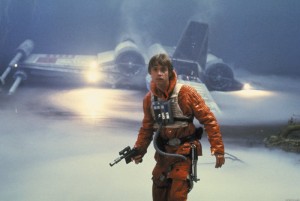
Andy: So that was detached from the Dagobah set.
Brian: Oh yes. They couldn’t do that. They tried to do it by pulling it out of the actual water, but you can’t suck an R2D2 out on a cable . So I redid the top of the lake, but we did on a big table, about half the size of this pool. We made an oval hole through the top of the table, and I got a big air ram, relatively short.
I had a spare R2D2, and we put a tube inside the R2D2, that went up the whole length of it, and blocked it off at the top. And then fitted that over the end of the air ram, with a seal in it, and I put tiny scalpel blades on the roof of R2-D2. And I had these silicone rubber sheets made which we stretched over the oval hole, and we covered the whole thing in liquid nitrogen, so there was all the mist, and reflected bits. And Richard Edlund lit it for me. And I stood on the stage with my little button in my hand, and a compressed air bottle set up, and R2 was loaded onto this thing. We said right, let’s get ready to go.
The cameras were set up, we had three cameras on it, and the door opened, and George Lucas walked in, with Francis Ford Coppola, and half of the Paramount chiefs, and Fox people, and Christ knows what – it was like a Garrison of producers and everything else. So I said alright, we’re ready to go. And I thought holy shit, I’m standing with this thing behind my back. And on the wall, we had this net to catch the R2D2. Because we knew we were going to have to do it more than once. And there were about 12 of these skins, and I picked the one I liked, just prior to the people coming.
So I stood there, cameras rolled at high speed, 3 2 1 go… and on the net, the boys had put up a bulls eye. They asked me where they should put it. I told them how high I thought it would go, and they placed bets on where the R2 would go, or whether it would never even get there or whatever. And it came out – and it was perfect. It hit the net, and it the bullseye right in the middle of the net. It was perfect. Pure luck. Not only that, all the suits went oh, great, thanks very much. And off they went. And I was thinking oh shit, it worked the first time, it doesn’t ever work the first time.
And then we put another membrane on and tried it again, and the membrane just stretched. It went “twang!” We did it again and again. I didn’t know but what happened was the guy in the model department, who had been given the job of molding, pouring, mixing the silicone and pouring it out had run out of the right stuff. He only made one sheet out of the 12 that was the correct consistency. So I had picked the one out, just when there’s someone looking over my shoulder, and that was the right occasion wasn’t it? So we had to have more made with the right mixture. That would just stretch slightly and then slap. I could have had this condom like R2D2, with this mass of producers, and they’d be going, “oh… bloody English”.
When we came to do the pyrotechnics. To do pyrotechnics, we had to do all the shots… we rented an 80 foot high, San Francisco Orchestral rehearsal room. 80 feet high, it’s an old building, they moved to mission direct in San Francisco. So we got this big aluminum frame from a light show for a rock and roll concert. We hauled it up. I had this tube made, with a bell mount in it, and we had to keep going up and down 80 feet, so we put a pulley on the top. Otis lift cable, which has got a stainless steel core, and then around the outside is about 8 strands of electrical cable, so you can feed power up it, but the cable won’t break, because it has this bloody massive stainless steel core wrapped inside.
So that was used, and we pulled it up with a charge in this sort of mortar, and then fired it off, lowered it down, and then pulled it back up to the roof so we didn’t have to keep climbing back up to the roof. And I had these two guys – Thaine Morris, and David Pyor. I think he changed his name so it’s David Pyrotechnics or something, and they were good guys. They had a monitor set up, and they had all their mixes that they were doing and everything else. And from a long time ago I knew that if you’re going to do those things, you never use aluminum powder. Aluminum powder, under the right circumstances, will detonate juts like gel ignite would. It’s not one of those things that are stable. In fact, it’s stabilized in flash powder; it’s stabilized by putting other chemicals with it, to stop it from detonating. And I did say to them, no flash powder. No aluminum powder. “We’re okay, we’re okay.”
So we do the first few things, okay great. We’ve got like five cameras all pointing up, photosonics running up to god knows how many frames a second, about 800 frames per second, and the VistaVision high speed camera. And they’re all sort of looking up, and the guy goes okay, 3-2-1, and I’ve got these little LEDs, lights, as soon as I see all 5 are lit I press the button, the cameras are running, off it goes. And that was okay about 3 times, 4 times. And then we decided we wanted to do a bigger one. So I went in to see the guys, “we need a bigger one, but NO ALUMINUM POWDER.” “Okay okay.”
So, we come back, set this thing up, roll the cameras, BANG! It was such a huge bang. It was like unbelievable, like a grenade going off. Ping, ping ping ping. Shrapnel everywhere, hitting the girders and stuff. And we hauled this thing down, the whole rig down, and there had been one 50 mill tube running vertically, that we adjusted to go through the black velvet, that held the bell mount on, just below the black powder . And then the aluminum rig was up on the top. That was a big thing with tubes and chains and electric motors and everything else, which normally held lamps. The bellmount attached to this scaffold tube, had been clamped in about three places, and had pushed itself up through the clamps; there were big scored aluminum bits where it pushed this up. And the bell mounts where the mortar had gone, had vanished. It was just shrapnel all over the floor. Didn’t hit a soul, didn’t hit anything, didn’t hit the camera, nothing. And I went back to that little shed, little place where the boys were. And I looked on their screen- bloody hell they used aluminum powder. Don’t ever do that again.
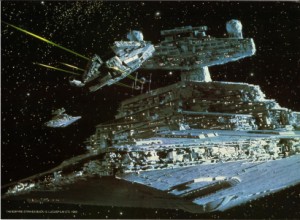
Stephen: So what was the shot that you were actually doing there?
Brian: You know the shot when the Star Destroyer explodes, when various things explode, and the stuff goes BANG and then comes towards you. You put the camera on the floor and then you point it up at the air, and you have black velvet everywhere and you just let it go, and it goes out, but it also comes down towards the camera. So that’s how you get it coming towards you. Otherwise if you do it from the side it just goes up, and done. You have to have the camera underneath.
Andy: What sort of work did you do on Dragonslayer? That was the first time they started using Go-Motion…
Brian: Yes. What happened was, it was a Disney-Paramount production. Matthew Robbins was the director and Hal Robbins produced it. They were both pals with George Lucas and Stephen Spielberg, they’d been in film school together. And at the time, I’d just been in a meeting with Stephen Spielberg about doing a thing called “Raiders of the Lost Ark,” – which I really wanted to do. I read the script and thought “ooh this is just up my street.” And I went to this thing and Steven said “Great news! Hal and Matthew have got their movie going. And Matthew wants you to do the effects.” So I said – I heard myself say, of course I’m not contracted to ILM. I’m only here on a one-picture basis. I really wanted to do Raiders of the Lost Ark. He said yeah but, Hal and Matthew are our best pals, and this is their big chance, will you do it for them? I said okay.
So I didn’t do Raiders of the Lost Ark, I would have loved to do Raiders of the Lost Ark. Maybe it was their excuse to get me out of the way, let Hal and Matthew have me instead. I don’t know. Anyway, so I did Dragonslayer. And Dragonslayer, which had the best animated dragon by Phil Tippet, I think personally, could have been a really great movie. It was… there were lots of problems with it.
We built, Disney built the dragon, basically. In LA. And then it was all shipped over to the UK. And then we had to fit the fire and stuff, things like that. Build the rig, make it move around and stuff. So we did that. Then I went back to ILM, and carried on with the post-production, where we did all the dragon stuff and the model stuff. And the rocks floating down the…. That rock face was 8 feet high, and 8 feet across. It was made out of microbaloons, what I did was get big electric motors behind the back with centric weights on them. And Steve Gawley, Lorne Petersen, a few others built the stuff.
We got a photosonic camera, running at about 1000 frames a second. We got that down at the bottom with a big wide-angle lens on it, and then we rolled the camera, and then we just wound the motors up so they started vibrating. Because its microbaloons, and they’re held together by acetate stuff, it’s very fragile. The moment you start vibrating, bits fall off. It looked good, didn’t it? I was really pleased with that. It looked like big chunks of rock and stuff. It was a tiny little set.
It’s difficult when it’s not in-house productions, when it’s not George Lucas, because everybody gives George what he asks for – because he’s the boss, you know. But when you have an outside contractor and they change their minds, and then they change their minds again, it’s not so good. And that’s what happened with Dragonslayer. They had a dragon that looked like a bloody X-wing. It kept sweeping through and sounding like a jet engine. All Phil’s wonderful animation stuff was basically not proceeded with, well some of it was used, when it was climbing up and stuff. But then when it was attacking, instead of having him actually flapping his wings and stuff, it just had this straight winged thing go shoooo through the frame. It looked like rubbish to me, I didn’t like that at all.
But you don’t have any choice, because you can only do what people ask you to do and that’s it. And when other people say what do you think of so and so, what do you think of their picture, I don’t really comment. Because you don’t know what their budget was, you don’t know if they had a major problem with the director, or whatever, which can happen. It can happen. I’ve heard stories about one particular director at Shepperton Studios, who was working on a picture and a friend of mine was doing the effects. Because something didn’t happen to do with a prop, or whatever it was to do, he got on the floor, foamed at the mouth and bit the carpet, the director! And banged his hands on the ground….
Brandon: [Looking at pictures] So that’s the special effects workshop there?
Brian: Yeah, absolutely, yes. You can see the boys working on the head mechanisms. And then when Kenny Baker was in it, when we had the Kenny Baker one, we had to take the centerfold from the Playboy anniversary edition. It had all these girls in miniature, we had to paste it on the inside of the thing to keep Kenny happy. He was a real character. He used to live down in East Borehamwood somewhere, he used to come up everyday. He had a Citroen Safari, one of those great big long Citroen Safari. And the pedals were extended, because he was a tiny little short guy with little short hands. He got done for speeding so many times.
Stephen: I think he had a converted Rolls Royce now. I’ve seen him at some of the conventions.
Brian: I’m sure he does.
Do you know what ever happened to the original Nostromo or anything like that? Didn’t they get burned at some expo or something?
Andy: Yeah, somebody said it’s in really bad condition. It was burned or something…
Brian: Yeah, I think it was too heavy.
Stephen: It’s like 2001, isn’t it, where the space station ended up in a field somewhere.
Brian: It’s Steedledge. …. with Tony Masters, yeah. I mean that was a surprise when I saw it, because everything else was packed into containers. There was a storage company alongside Elstree Studios, and they put everything into a 52-foot long. All the bits and stuff, everything was put in there, all stored away. And then when MGM went down the tubes, and they raised Borehamwood studios to the ground… that was the best studio in Europe, it was almost on par with the American studios. It was big, had massive stages, two stages opposite each other, with doors that would open up in the middle so you could have it as one massive stage, which we did on 2001 on a number of occasions. Someone came along and acid-stripped MGM, sold it off as warehouse space, then they flattened it and put new buildings up. So it was gone. Anyway, Stanley moved down to Elstree. After a while, MGM, what remained of MGM didn’t want to pay for the rental of everything being stored. So the storage company gave Stanley an ultimatum basically, they said we want money for this stuff and he said well I’m not paying you anything, and they took it out and trashed it all.
Brandon: A bit tragic.
Brian: That was really tragic. Because that stuff would have stood up today as being good stuff.
Stephen: Yeah, yeah absolutely. That’s just part of the UK cinematic history. That’s one reason people are springing up as collectors today, so they can grab this stuff and preserve it before it does disappear completely.
Brian: Well I’d like to wind my life back about 40 years, and I could be making a fortune.
Stephen: [Laughs] Tell me about it. You mentioned about having a friend that might still have a couple of bits.
Brian: From Empire?
Stephen: Yeah.
Brian: I haven’t spoken to him. We just haven’t been in touch recently. But I will get in touch with him.
Stephen: Okay. It’s the only sort of way to find these artifacts…
Brian: That stuff that we used doesn’t last. It just disintegrates, there’s no stabilizing it. The damn stuff is unstable.
Andy: Bob Burns has a lot of stuff, if you see the condition of it…
Stephen: Bob Burns, is that a name that sounds familiar?
Brian: No, who is that?
Andy: He used to host a big Halloween party, and he put on such an impressive one from the film, that 20th Century Fox gave him the majority of props from Alien and Aliens, basically the archive, and it’s in his basement.
Stephen: He has a book – next time I come down I’ll bring a book. There are Star Wars creature masks in there and all sorts of things, it’s an amazing collection.
Brandon: Originally he just did an Alien Halloween show, and then Fox was so impressed with what he did that they brought him down the original sets, they were all crated up, and they just reconstructed it out in a field.
Brian: That was the thing about Alien, the original Alien, we finished shooting at Shepperton. But then Ridley wanted to extend things and because he was really seriously late and they had to get out of Shepperton, they packed up all the sets, stored them all at Bray, and then one by one built them at the big stage at Bray and virtually reshot the thing.
Stephen: Really? My God…
Brian: Well, certainly they enhanced sequences to make sure that they got the correct dramatic effect and stuff.
Stephen: That’s not an easy thing to do, pack up a set and then rebuild it. I mean I’ve seen a few sets that have been packed up with the idea of rebuilding them, but it’s kind of starting from scratch almost.
Stephen: How many R2D2s did you build then, for Empire?
Brian: Oh, it was seven I think. Something like seven. We had a Kenny Baker one, and then we had a lightweight one which I had shipped out to the states. To do the thing, which was just a shell. That’s two. And then we had…
Stephen: And then there was another lightweight? For if you missed that net?
Brian: I think we probably had 2, but I only had one out there with me. And then we had the one that threw its leg forward, changed from a 2 to a 3. So that’s three. And then we had three of the normal jobbies that floated around, the radio control jobs. And then we had a spare. So I think that was seven in all.
Stephen: At that stage, they were still using Kenny a lot?
Brian: Because, Kenny could jump around and do this and that stuff which didn’t work as a radio controlled job. He put real character into it. I’m pretty sure that we actually moved him around. I think we had him in there, but we could make him move as well, in one of them.
Stephen: Some heavy-duty motors in there.
Brian: They were all pancake, Semarian-Cobal motors, and they were pretty sophisticated things, with plenty of power but not too much drain. And then we had to get batteries in it as well.
Stephen: It’s amazing how the design has stood the test of time though.
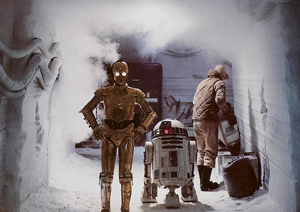
Brian: Yep! Ralph McQuarrie. When I worked on Empire, and I went over to the states, I was at George’s house and he said look, this is what we’ve got. This is the planet Hoth, with the ice cave and everything else, and they had all these conceptual paintings. Then the production designer comes along…. Everything that Ralph did, was a painting two years before. You can look at his paintings and then look at the set, and they were identical. Because that’s what George wanted. George wanted what Ralph gave him. Or he’d say to Ralph I want to change this, I want to change that. It was Ralph who really conceptualized the whole thing, and really knew what we were doing. Because before we even started, we knew what the sets were going to look like. You got a feeling for what it was going to be like – that was absolutely brilliant.
Brandon: So when you went to build the R2s, did you talk with John Stears and the guys from the first one about it?
Brian: No. He threatened to sue me because… I was asked in some program what was happening with the R2D2s, and I said we were going down a completely different route to make them five times lighter and everything else. “How dare you?” I said John, go and look at Star Wars. Show me the shots with the wires in it and I’ll show you a radio-controlled R2-D2 that doesn’t need wires pulling it. So don’t give me that shit. It’s just an ego between effects artists.
Stephen: I suppose understandable at the end of the day.
***END TAPE***
***BEGIN TAPE***
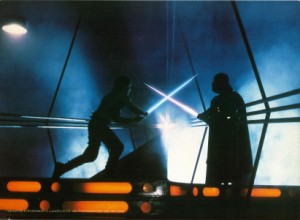
Brandon: Was there any discussion about you being involved with the lightsabers for the second one? Because I know special effects worked on the lightsabers for the first one…
Brian: It was crap. They rotoscoped over it. That was just a publicity thing. No, there wasn’t any work there. They just had a stick coming out of it, just a guide for the rotoscoping. Much more effectively actually then… They had this thing about having rotating things with front projection. Crap, all that stuff. Just a split screen. On the second one anyway, we didn’t go down that road.
Brandon: So what other kinds of things were you working on for special effects to prepare for the Norway shoot?
Brian: All the explosion stuff, the plates for when we added the speeders afterward, when they crashed and all that stuff. The droid… there was enough to do there, for the five weeks we were there.
Andy: Is that a maquette there? Is that a shooting miniature or…?
Brandon: They built the first one at ILM didn’t they?
Brian: I think that come over from ILM, and then we copied that. To make the big one.
Stephen: Was that one unit built again, just had one of these things again?
Brian: Yeah, yeah. That was the last shot we did with that.
Stephen: It must be nerve wracking to only have one and you’re out there in Norway and you’re going to blow it up, if you don’t get the shot…
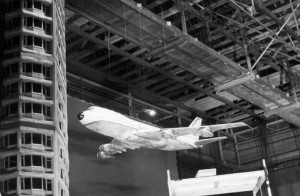
Brian: Yeah, but that’s what you’re paid for really. I did a thing called Medusa Touch for Richard Burton, where a 747 had to crash into a skyscraper. The producer phoned me up the night before we did the shoot. A- he could only afford one 747 10-foot model, couldn’t afford a second one, so we had to do it first take. And B, he phoned me up the night before and said I just thought I’d let you know, I haven’t bothered to insure it because you’ve got such a good reputation. I thought I’d save the money and spend it elsewhere.
Stephen: [Laughs] I bet you slept well that night.
Brian: So I said, “thanks!” And what happened was, we wired it up, and we had these big wheels to wrap the cables around. We had to accelerate it across the studio floor to as high speed as we could get. When you have the thing on a parallelogram, if you accelerate the thing you’re pulling, the aircraft goes up like that. The back goes forward. You’ve got this big massive aircraft, and then it very slowly comes down the wires and gets lower as it accelerates. So we had a diagonal wire on there, just to make sure that it stayed roughly parallel.
What happened was, the force that took the weight of the aircraft translated itself into a sort of sideways motion. So it actually came down the wire almost sideways, I was standing looking straight at it. And I had the building, it was blown to bits, made out of polyurethane foam, and then in the windows I had 35 mil film, so it looked like there were things in all the windows and stuff. But I had it all made individually so that when it hit, it didn’t break up in great sections of building, and look like a model.
To my horror, I saw it coming down with the cameras going rolling away about 130 frames a second, I saw this thing coming down almost sideways, it had just started to straighten up in the end. Because when you see it on the film, it comes in, but because it yorred the way it did you can’t really tell, and it sort of straightened up. And then it hit the building and blew up, and it crashed and flamed and stuff.
And I’d had the building plumbed with a big 4″ water main with sprinklers coming out all the way to the top. Because I knew this was polyurethane it would catch fire. I had the water on the inside coming out, with sprays and other things, CO2, carbon coming out. The art department had produced a photograph, a newspaper to shoot on the set, the newspaper shows the building after the event. They had decided that they would have, this is in 1976, the tail of a 747 sticking out of the building.
And I took one look at this when I walked on the set and said, “you can’t do that”. What do you mean you can’t do that, it’s what we’re shooting? I said if a 747 hit a skyscraper, you would not see anything, it would just absolutely turn into tiny bits of metal. You wouldn’t have a tail sticking out of the building. “Oh well, we think you would. And it’s photographically more interesting.”
So anyway, I had a local photographer who turned out to be a really ace photograph, and he had three cameras all with motor drives on them. He set them up, and he got the shot of the 747 going into the building with the explosion, with the tail sticking out. So afterward, I went along to the production designer and said there you go, there it is, there’s your tail sticking out of the building. I said this is shot fraction of a second later, and it’s just flame, nothing else.
Anyway, I’ve got to carry on guys, and do other things…
***END TAPE***
Special thanks to Brandon for sharing his interview with the site and readers.
Jason De Bord

